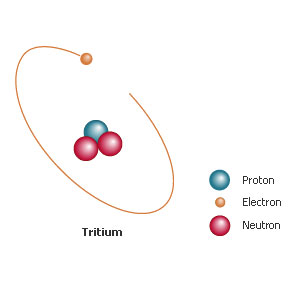Radioactive Waste 96 - Tritium from Nuclear Reactors is a Major Biological Threat
Tritium is a radioactive isotope of hydrogen that has two neutrons in the nucleus in addition to the single proton. Radioactive beta particles are emitted by tritium. (Beta particles are high energy electrons or positrons.) Since water is contained in living cells, heavy water with tritium instead of normal hydrogen is easily absorbed by living tissue when it is consumed. It can also enter a living body by being inhaled as water vapor. If the tritium is incorporated into organic compounds instead of being excreted or exhaled, it is referred to as organically bound tritium (OBT) and it can remain in a human body for up ten years, emitting beta particles.
If a beta particle from tritium hits the DNA in the nucleus of a living cell, it can cause mutations. If the DNA mutated is part of an important gene, the mutation can cause serious diseases. Laboratory animals exposed to tritium have developed cancer and birth defects. Research has shown that tritium can deliver what is called relative biological effectiveness in terms of radiation damage to living tissue at a rate of up to five times that of cosmic rays or x-rays.
Tritium is created naturally when cosmic rays collide with the Earth's atmosphere. It is also created by human activity such as the manufacture and testing of nuclear weapons. It can also be released as a gas or water vapor by the normal operation of a nuclear power plant. In nuclear accidents at power plants, much greater releases of tritium are possible. It is estimated that nuclear power plants release tens of thousands of curies into the atmosphere and tens of millions of picocuries per liter into bodies of water near operating reactors.
The NRC allows a licensed nuclear power plant to release a planned quantity of tritium into the environment that could result in a member of the public receiving a maximum of one milliseievert per year. Tritium has a half-life of about twelve years. Although increasing amounts of tritium are being released by normal nuclear reactor operations and nuclear accidents at nuclear power plants, the NRC does not require water or steam containing tritium to be filtered because there is no existing commercial technology that can remove tritium for water or water vapor.
Much has been written about massive tritium releases caused by the nuclear disaster at Fukushima in March of 2013. The fuel cores of three of the Fukushima reactors melted down and may have escaped from the reactors. In any case, the integrity of the reactors' containment vessels has been destroyed. Ground water is flowing through the area containing the cores where it picks up tritium. In May of 2014 it was reported that the level of tritium in the water beneath the crippled power plant is exceeding the level which is allowed for dumping water directly into the Pacific Ocean.
The contaminated water has been pumped into storage tanks but the tanks are rapidly being filled and some are leaking. TEPCO attempted to freeze the soil around the reactors that melted down in an attempt to create an "ice wall" to contain the contaminated water but that plan has failed. Water from the area around the destroyed reactors is now flowing directly into the Pacific Ocean. At this point, it is estimated that water containing tritium will continue to be released into the Pacific Ocean from Fukushima for the foreseeable future. This poses a danger to all life on Earth.
